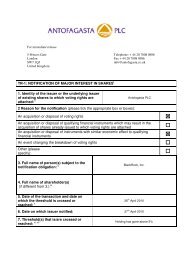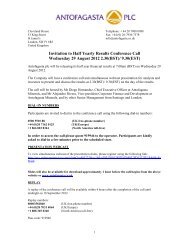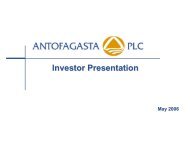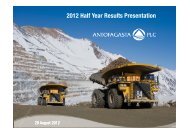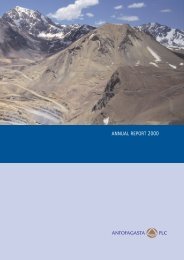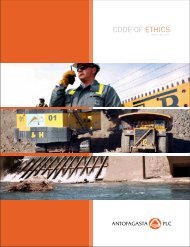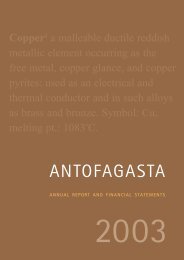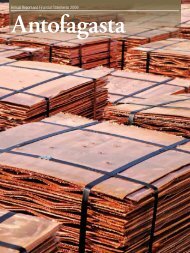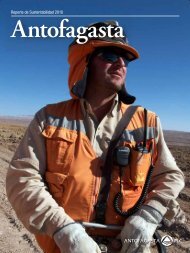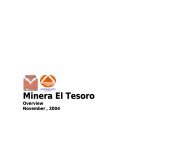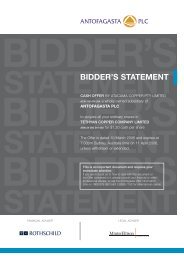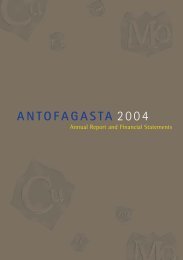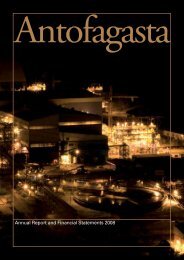Sustainability Report - Antofagasta PLC
Sustainability Report - Antofagasta PLC
Sustainability Report - Antofagasta PLC
You also want an ePaper? Increase the reach of your titles
YUMPU automatically turns print PDFs into web optimized ePapers that Google loves.
What is the issue?<br />
Energy<br />
Energy consumption is increasing in<br />
Chile by around 7% annually and<br />
production is struggling to meet this<br />
growing demand. The energy-intensive<br />
mining sector accounts for<br />
approximately 50% of the country’s<br />
total energy consumption. The amount<br />
of energy used to extract a tonne of<br />
copper will rise as older operations<br />
typically produce lower grade ore and<br />
the ore will tend be in less accessible<br />
areas. Rising energy needs, reliability of<br />
supplies of fossil fuels, decreasing<br />
precipitation affecting hydropower<br />
projects and climate change legislation<br />
keep energy security and energy<br />
efficiency high on the Group’s agenda.<br />
Chile’s energy system is divided into<br />
two regional grids with distinct energy<br />
compositions. The SING grid supplies<br />
the north, including the Atacama desert<br />
where three of the Group’s mining<br />
operations are located. It is powered<br />
mostly by imported coal and natural<br />
gas. Its emission factor is double that of<br />
the SIC grid, powered mainly by<br />
hydropower, which supplies the centre<br />
and south of Chile where our biggest<br />
operation, Los Pelambres, is located.<br />
In 2011 <strong>Antofagasta</strong> Minerals undertook a study to<br />
understand the potential effects of climate change on the<br />
business and identify future energy needs and potential CO 2<br />
emissions. We identified a baseline for greenhouse gas<br />
(GHG) emissions from 2011 and projected future emissions<br />
up to 2020. According to the study, we can expect our<br />
greenhouse gas emissions to increase by 3% from 2012 to<br />
2017 as the grade of mineral ore that we extract decreases.<br />
The study enabled us to identify and analyse plans to<br />
mitigate our climate change impact and we are developing<br />
‘Climate Change Guidelines’ for the division. These will help<br />
us manage the risks and realise the opportunities related to<br />
climate change.<br />
Energy efficiency and alternative<br />
sources<br />
In 2011 energy consumption increased compared to 2010,<br />
due to increased production at Los Pelambres following the<br />
completion of the mine expansion in 2010. Energy<br />
consumption also increased with Esperanza’s first full year<br />
of operation. Decreasing ore grade, which requires more<br />
energy to extract, was also a factor at some mines.<br />
Reducing energy consumption is a challenge as ore grades<br />
decrease and we respond to this challenge by striving for<br />
maximum efficiency and finding alternative energy sources.<br />
We monitor energy efficiency in terms of energy intensity,<br />
which we measure as kilowatt hours per tonne of fine<br />
copper produced.<br />
KWh per tonne of fine copper produced<br />
Los Pelambres<br />
Esperanza<br />
El Tesoro<br />
Michilla<br />
n/a: not applicable.<br />
2011<br />
3,270<br />
7,151<br />
3,015<br />
3,634<br />
2010<br />
3,124<br />
n/a<br />
2,993<br />
3,664<br />
2009<br />
3,048<br />
n/a<br />
2,775<br />
3,659<br />
<strong>Antofagasta</strong> Minerals 51<br />
Overview<br />
<strong>Sustainability</strong> at <strong>Antofagasta</strong> <strong>Antofagasta</strong> Minerals <strong>Antofagasta</strong> Railway Company Aguas de <strong>Antofagasta</strong> Appendices



